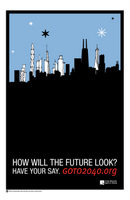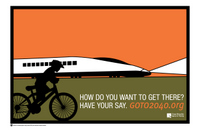Second of two
The criticism of Daniel Burnham has long been that his approach to planning was top-down. He and his colleagues --- educated, informed and generally rich --- analyzed the needs of the Chicago region, and then came down from the mountain with the Plan of Chicago.
Of course, it really wasn’t quite so top down. Very little of the Plan’s ideas would have been implemented if everyday Chicagoans hadn’t voted 86 times to approve bond issues to pay for the improvements. But, no denying, the public’s involvement in shaping the Plan was all after-the-fact.
That’s not the case this time around.
This time, you --- yeah, you! --- can have a hand in planning the future of the metropolitan region.
A century after the publication of the Burnham Plan, the Chicago Metropolitan Agency for Planning (CMAP) is in the midst of what is likely to be the most significant planning effort for metropolitan Chicago since Burnham put pencil to paper.
.jpg)
GO TO 2040, scheduled to be finalized in the fall of 2010, will be the first comprehensive plan for the city and suburbs to integrate such major issues as transportation, land use and the environment. As its name suggests, it will cover the next 30 years, a period in which the population of the region is expected to increase by 2.8 million, or about 34 percent.
And CMAP will be the first planning agency in the region with the clout to implement its plan by rewarding projects that fit the plan’s goals and penalizing those that don’t.
To be sure, the constant mantra of CMAP officials is that it won’t be CMAP’s plan, it’ll be yours. Certainly, you and everyone else in the Chicago region will have a chance to have your say. (In fact, “Have Your Say!” is another of the agency’s chants.)
 As I described in my last posting, CMAP has scheduled nearly 60 workshops this summer throughout the city and suburbs at which participants work together to develop a scenario for future development. More than a dozen remain to be held before the beginning of September.
As I described in my last posting, CMAP has scheduled nearly 60 workshops this summer throughout the city and suburbs at which participants work together to develop a scenario for future development. More than a dozen remain to be held before the beginning of September.
The equivalent of a voting booth
But you don’t have to leave your home or be part of a group in order to make your voice and ideas heard. Just go online and head for a CMAP web page that’s the equivalent of a voting booth.
This page gives your three ways of getting involved in the planning --- Visit 2040, Invent 2040 and Compare 2040.
Visit 2040 is a simple, dip-your-toe-in-the-water program in which you watch three short videos about planning possibilities and answer two questions: How would you plan new development? How would you plan for more trips? Then, based on your answers, the program explains in a few sentences how life in the region would be different.
For instance, if you choose a metropolitan focus for new development (i.e., little or no building on the suburban fringe) and a focus on public transportation, the result, you’re told, is that more open space is preserved, commuter times are shorter, the air quality is better and money is saved.
If you choose a transit emphasis on autos and the present pattern of unfocused development, the narrator tells you, “By allowing growth to spread out, we’ve lost hundreds of square miles of open space…Getting around is pretty slow for many people.” In addition, costs are up, and air quality is down.
Stacking the deck?
 It may seem that CMAP is stacking the deck in favor of some things and against others. And it is. The agency’s wording, for example, makes the viewer think that building new roads and a continued focus on drivers will increase air pollution. Which, of course, is what would happen.
It may seem that CMAP is stacking the deck in favor of some things and against others. And it is. The agency’s wording, for example, makes the viewer think that building new roads and a continued focus on drivers will increase air pollution. Which, of course, is what would happen.
In other words, CMAP is stressing the real-world implications of decisions, based on the facts.
Visit 2040 is essentially an educational tool. By answering the questions, you learn more about how planning decisions impact life in future years. But the answers aren’t fed into the CMAP database. (In addition to online, you can also run through Visit 2040 at 11 community festivals and kiosk locations around the metropolitan area.)
Vote!
To register a vote on how the future should evolve, you need to go into the Invent 2040 area of the web page.
.jpg)
Here, you find six categories along the left-side rail --- development density, development location, road network, transit system, transportation policy and policies regarding natural resources. You’re asked to choose one of three or four possible approaches in each category, and, by doing so, you create a scenario.
Along the right-side rail of the page, eight topics are listed --- land consumption, detached homes, single-occupant vehicles, commuting time, energy use, water use, government costs and household costs. A line chart below each topic shows the extent to which your scenario will result in more or less of that topic, such as greater energy usage or lower household costs.
Once you’ve completed a scenario, you click on a button at the top to submit it to the CMAP database. But, first, you’re asked to give it a ranking of one to five stars, with five stars being your preferred scenario and one star being the opposite of the way you want the future to look.
And you’re given a space to write in whatever comments you’d like to share with the agency.
Planning geeks only
If you’re really a planning geek, you can click on Compare 2040 to see how your scenario stacks up against current trends and against three very detailed scenarios that CMAP has developed. Each CMAP scenario emphasizes a different aspect --- Preserve, Reinvest and Innovate.
If you’re hungry to know more about the process, you can go to the CMAP document that underlies GO TO 2040, a 28-page booklet, also available online, “Regional Vision for Metropolitan Chicago” which identified nine themes the plan must address: quality of life, natural environment, social systems, economy, infrastructure, governance, sustainability, equity and innovation.
The CMAP comprehensive plan is set to go into effect in 2011, if all goes well. For the next 30 years, it will serve as a blueprint for the evolution of the Chicago region.
 It’ll be known as the GO TO 2040 plan, or maybe the CMAP Plan. But, since so many people are getting involved in creating it, it’s unlikely it’ll be known --- as the Burnham Plan has been --- by the name of some individual planner or planning leader.
It’ll be known as the GO TO 2040 plan, or maybe the CMAP Plan. But, since so many people are getting involved in creating it, it’s unlikely it’ll be known --- as the Burnham Plan has been --- by the name of some individual planner or planning leader.
Yet, if you vote on what you want the future to look like, you’ll own a piece of the plan.
And, in your own mind, you’ll be able to think of it as the (Your Name Here) Plan.
For a print-friendly version of this post, go here.
Blog Categories
- art (14)
- civic engagement (17)
- culture (16)
- future (26)
- green legacy (15)
- history (26)
- pavilions (4)
- schools (8)
- transportation (7)
